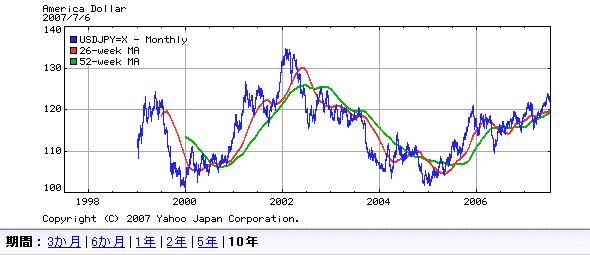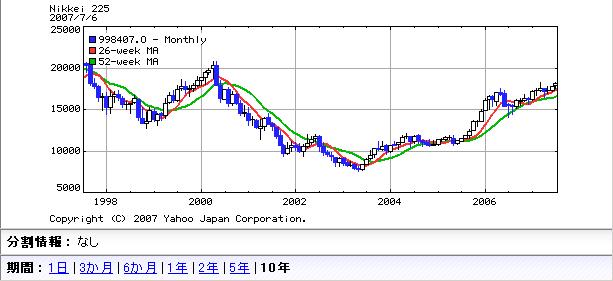http://en.wikipedia.org/wiki/Japanese_p ... ic_miracle
Japanese post-war economic miracle" is the name given to the historical phenomenon of Japan's record period of economic growth following World War II, spurred both by United States investment and Japanese government economic interventionism in particular through their Ministry of International Trade and Industry. [1] The distinguishing characteristics of the Japanese economy during the 'economic miracle' years included: the cooperation of manufacturers, suppliers, distributors, and banks in closely knit groups called keiretsu; the powerful enterprise unions and shuntō; cozy relations with government bureaucrats, and the guarantee of lifetime employment (shūshin koyō) in big corporations and highly unionized blue-collar factories. Since 1993, Japanese companies have begun to abandon some of these norms in an attempt to increase profitability.
[edit] American contributions
In 1946, commercial burdens from wartime expenses threatened economic ruin. Post-war inflation, unemployment and shortages in all areas seemed overwhelming. Japans immediate economic improvement was not achieved on its own. The American government, under the auspices of the Supreme Commander of the Allied Powers (SCAP), played a crucial role in Japans initial economic recovery. SCAP officials believed economic development could not only democratize Japan but also prevent the reemergence of militarism, and forfend communism in the Land of the Rising Sun. Military hostilities in the Korean peninsula further boosted the economy in 1950 because the U.S. government paid the Japanese government large sums for "special military procurement." These payments amounted to 27% of Japans total export trade. The United States also insisted that Japan be admitted to GATT as a "temporary member" over British opposition. During the Korean War, SCAP departed and full sovereignty was returned to the government of Japan.
[edit] Governmental contributions
The Japanese financial recovery continued even after SCAP departed and the economic boom propelled by the Korean War abated. Japans economy survived the deep recession caused by a loss of the U.S. payments for military procurement and continued to make gains. By the late 1960s, Japan had risen from the ashes of World War II to achieve an astoundingly rapid and complete economic recovery. According to Mikiso Hane, the period leading up to the late 1960s saw "the greatest years of prosperity Japan had seen since the Sun Goddess shut herself up behind a stone door to protest her brother Susano-o's misbehavior." The Japanese government contributed to the post-war Japanese economic miracle by stimulating private sector growth first instituting regulations and protectionism that effectively managed economic crises and later by concentrating on trade expansion.
[edit] Ministry of International Trade and Industry role
Main article: Ministry of International Trade and Industry
The Ministry of International Trade and Industry (MITI) was instrumental in Japan's post-war economic recovery. According to some scholars, no other governmental regulation or organization had more economic impact than MITI. The particular speed, form, and consequences of Japanese economic growth, Chalmers Johnson writes, are not intelligible without reference to the contributions of MITI (Johnson, vii). Established in 1949, MITIs role began with the "Policy Concerning Industrial Rationalization" (1950) that coordinated efforts by industries to counteract the effects of SCAPs deflationary regulations. In this way, MITI formalized cooperation between the Japanese government and private industry. The extent of the policy was such that if MITI wished to double steel production, the neo-zaibatsu already has the capital, the construction assets, the makers of production machinery, and most of the other necessary factors already available in-house. The Ministry coordinated various industries, including the emerging keiretsu, toward a specific end, usually toward the intersection of national production goals and private economic interests.
MITI also boosted the industrial sector by untying the importation of technology from the importation of other goods. MITI's Foreign Capital Law (1950) granted the ministry power to negotiate the price and conditions of technology importation. This element of technological control allowed it to promote industries it deemed promising. The low cost of imported technology allowed for rapid industrial growth. Productivity was greatly improved through new equipment, management, and standardization.
MITI gained the ability to regulate all imports with the abolition of the Economic Stabilization Board and the Foreign Exchange Control Board in August 1952. Although the Economic Stabilization Board was already dominated by MITI, the Yoshida Governments transformed it into the Economic Deliberation Agency, a mere "think tank," in effect giving MITI full control over all Japanese imports. Power over the foreign exchange budget was also given directly to MITI.
MITI's establishment of the Japan Development Bank (1951) also provided the private sector with low-cost capital for long-term growth. The Japan Development Bank introduced access to the Fiscal Investment and Loan Plan (FILP), a massive pooling of individual and national savings. At the time FILP controlled four times the savings of the world's largest commercial bank. With this financial power, FILP was able to maintain an abnormally high number of Japanese construction firms (more than twice the number of construction firms of any other nation with a similar GDP).
[edit] Ikeda administration and Keiretsu
In 1954, the economic system MITI had cultivated from 1949 to 1953 came into full effect. Prime Minister Ikeda Hayato, who Johnson calls "the single most important individual architect of the Japanese economic miracle," pursued a policy of heavy industrialization. This policy lead to the emergence of over-loaning (a practice that continues today) in which the Bank of Japan issues loans to city banks who in turn issue loans to industrial conglomerates. Because there was a shortage of capital in Japan at the time, industrial conglomerates borrowed beyond their capacity to repay, often beyond their net worth, causing city banks in turn to overborrow from the Bank of Japan. This gave the national Bank of Japan complete control over dependent local banks.
The system of over-loaning, combined with the government's relaxation of anti-monopoly laws (a remnant of SCAP control) also led to the reemergence of conglomerate groups called keiretsu that mirrored the wartime conglomerates, or zaibatsu. Keiretsu efficiently allocated resources and became competitive internationally.
At the heart of the keiretsu conglomerates' success lay city banks, which lent generously, formalizing cross-share holdings in diverse industries. The keiretsu spurred both horizontal and vertical integration, locking out foreign companies from Japanese industries. Keiretsu had close relations with MITI and each other through the cross-placement of shares, providing protection from foreign take-overs. For example, 83% of Japans Development Banks finances went toward strategic industries: shipbuilding, electric power, coal and steel production. Keiretsu proved crucial to protectionist measure that shielded Japans sapling economy.
Keiretsu also fostered an attitude shift among Japanese managers that tolerated low profits in the short-run because keiretsu were less concerned with increasing stock dividends and profits and more concerned about interest payments. Approximately only two-thirds of the shares of a given company were traded, cushioning keiretsu against market fluctuations and allowing keiretsu managers to plan for the long-term and maximize market shares instead of focusing on short-term profits.
The Ikeda Administration also instituted the Foreign Exchange Allocation Policy, a system of import controls designed to prevent the flooding of Japans markets by foreign goods. MITI used the foreign exchange allocation to stimulate the economy by promoting exports, managing investment and monitoring production capacity. In 1953, MITIs revised the Foreign Exchange Allocation Policy to promote domestic industries and increase the incentive for export capacity revising the export-link system. A later revision confirmed based production capacity on foreign exchange allocation to prevent foreign dumping.
[edit] "Golden Sixties" and shift to export trade
The period of rapid economic growth between 1955 and 1961 paved the way for the "Golden Sixties". The second decade that is generally associated with the Japanese economic miracle. In 1965, Japan's nominal GDP was estimated at just over $91 billion. Fifteen years later, the nominal GDP had soared to a record $1,065 billion by 1980.
Under the leadership of Prime Minister Ikeda, former minister of MITI, the Japanese government undertook an ambitious "income-doubling plan." Ikeda lowered interest rates and taxes to private players to motivate spending. In addition, due to the financial flexibility afforded by the FILP, Ikedas government rapidly expanded government investment in Japans infrastructure: building highways, high-speed railways, subways, airports, port facilities, and dams. Ikeda's government also expanded government investment in the communications sector of the Japanese economy previously neglected. Each of these acts continued the Japanese trend towards managed economy the epitomizes the mixed economic model.
Besides Ikeda's adherence to government intervention and regulation of the economy his government pushed trade liberalization. By the April of 1960, trade imports had been 41 percent liberalized (compared to 22 percent in 1956). Ikeda planned to liberalize trade to 80 percent within three years. His plans however met severe opposition from within Japanese society.
However, governmental plans to liberalize trade faced fierce opposition from both industries who had thrived on over-loaning and the nationalist public who feared foreign enterprise takeovers. The Japanese press likened liberalization to "the second coming of the black ships," "the defenselessness of the Japanese islands in the face of attack from huge foreign capitalist powers," and "the readying of the Japanese economy for a bloodstained battle between national capital and foreign capital." Ikeda's income-doubling plan was largely a response to this growing opposition and widespread panic over liberalization, adopted to quell public protests. Ikeda's motivations were purely pragmatic and foreign policy based however. He moved toward liberalization of trade only after securing a protected market within through internal regulations that favored Japanese products and firms.
Ikeda also set up numerous allied foreign aid distribution agencies to demonstrate Japans willingness to participate in the international order and to promote exports. The creation of these agencies not only acted as a small concession to international organizations, but also dissipated some public fears about liberalization of trade. Ikeda furthered Japans global economic integration by joining the GATT in 1963, the IMF, and the OECD in 1964. By the time Ikeda left office, the GNP was growing at a phenomenal rate of 13.9 percent despite a largely protected domestic economy.
In 1962 Kaname Akamatsu has published his famous article introducing the Flying Geese Paradigm. It postulated that Asian nations will catch up with the West as a part of a regional hierarchy where the production of commoditized goods would continuously move from the more advanced countries to the less advanced ones. The paradigm was named this way due to Akamatsu's envisioning this pattern as geese flying in unison with Japan being an obvious leader.

